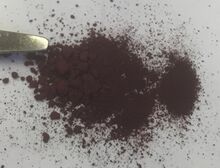Chemistry:Cyclopentadienylmolybdenum tricarbonyl dimer

| |

| |
| Names | |
|---|---|
| IUPAC name
bis(tricarbonyl[η5-cyclopentadienyl]
| |
| Other names
cyclopentadienyl molybdenum
carbonyl dimer
Bis(tricarbonylcyclopentadienylmolybdenum) | |
| Identifiers | |
3D model (JSmol)
|
|
| ChemSpider | |
| EC Number |
|
PubChem CID
|
|
| |
| |
| Properties | |
| Mo2(η-C5H5)2(CO)6 | |
| Molar mass | 489.96 g/mol |
| Appearance | dark red crystalline solid |
| Melting point | 222 °C (432 °F; 495 K) |
| Boiling point | dec. |
| insoluble | |
| Structure | |
| monoclinic | |
| 0.112 D | |
| Hazards | |
| Main hazards | flammable |
| GHS pictograms |  
|
| GHS Signal word | Danger |
| H302, H312, H332 | |
| Related compounds | |
Related compounds
|
(η-C5H5)2Mo2(CO)4 |
Except where otherwise noted, data are given for materials in their standard state (at 25 °C [77 °F], 100 kPa). | |
| Infobox references | |
Cyclopentadienylmolybdenum tricarbonyl dimer is the chemical compound with the formula Cp2Mo2(CO)6, where Cp is C5H5. A dark red solid, it has been the subject of much research although it has no practical uses.
Structure and synthesis
The molecule exists in two rotamers, gauche and anti.[1] The six CO ligands are terminal and the Mo-Mo bond distance is 3.2325 Å.[2] The compound is prepared by treatment of molybdenum hexacarbonyl with sodium cyclopentadienide followed by oxidation of the resulting NaMo(CO)3(C5H5).[3] Other methods have been developed starting with Mo(CO)3(CH3CN)3 instead of Mo(CO)6.[4]
Reactions
Thermolysis of this compound in hot solution of diglyme (bis(2-methoxyethyl)ether) results in decarbonylation, giving the tetracarbonyl,[4] which has a formal triple bond between the Mo centers (dMoMo = 2.448 Å):[5]
- (C5H5)2Mo2(CO)6 → (C5H5)2Mo2(CO)4 + 2 CO
The resulting cyclopentadienylmolybdenum dicarbonyl dimer in turn binds a variety of substrates across the metal-metal triple bond.
Related compounds
References
- ↑ Brian Mann (1997-01-06). "Fluxionality of Cp2Mo2(CO)6". University of Sheffield. http://brian-mann.staff.shef.ac.uk/Cp2Mo2CO6.html.
- ↑ R. D. Adams, D. M. Collins, and F. A. Cotton (1974). "Molecular Structures and Barriers to Internal Rotation in Bis(η5-cyclopentadienyl)hexacarbonylditungsten and Its Molybdenum Analog". Inorg. Chem. 13 (5): 1086–1090. doi:10.1021/ic50135a015.
- ↑ Manning, A. R.; Hacket, Paul; Birdwhistell, Ralph (1990). "Hexacarbonylbis(η5-Cyclopentadienyl)Dichromium, Molybdenum, and Tungsten and their Analogs, M2(η5-C5H4R)2(CO)6 (M = Cr, Mo, and W; R = H, Me or PhCH2)". Inorganic Syntheses 28: 148–149. doi:10.1002/9780470132593.ch39. ISBN 9780470132593.
- ↑ 4.0 4.1 Curtis, M. David; Hay, Michael S. (1990). "Cyclopentadienyl Metal Carbonyl Dimers of Molybdenum and Tungsten". Inorganic Syntheses. Inorganic Syntheses. 28. pp. 150–152. doi:10.1002/9780470132593.ch40. ISBN 9780470132593.
- ↑ Cotton, F. A.; Walton, R. A. "Multiple Bonds Between Metal Atoms" Oxford (Oxford): 1993, p 564ff. ISBN:0-19-855649-7.
 |

